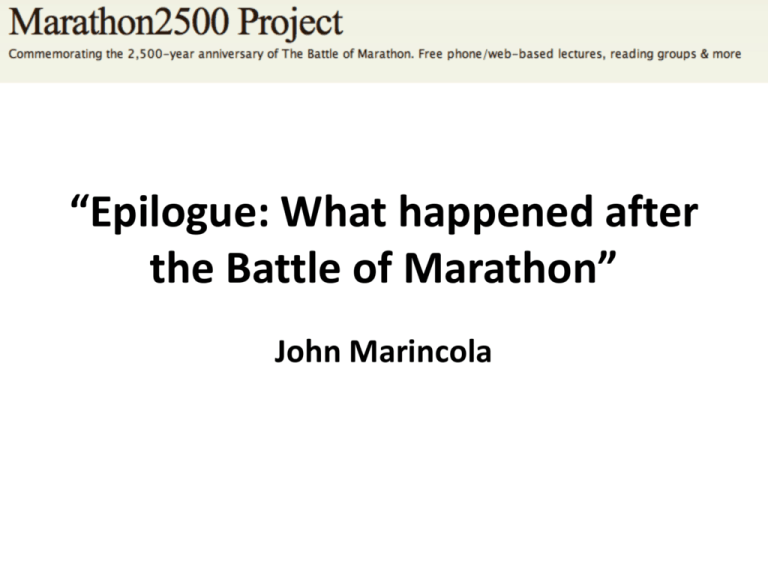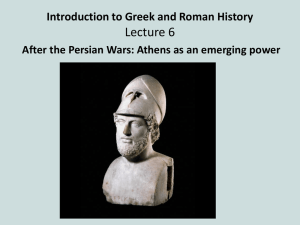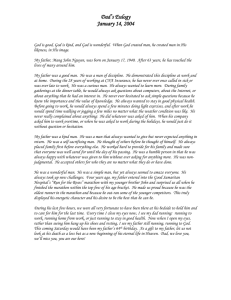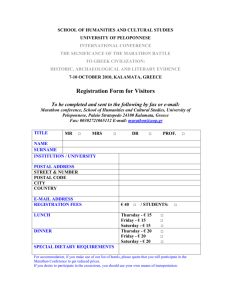JohnMarincola-June8-2011-Epilogue
advertisement

“Epilogue: What happened after the Battle of Marathon” John Marincola The Marathon Soros 1 The New Marathon inscription The inscription was discovered at the villa of Herodes Atticus, a 2nd century CE orator and public benefactor. The inscription is a casualty list of the fallen from the Erechtheis tribe. 2 The Marathon inscription discovered at the villa of Herodes Atticus 3 From the new Marathon stele: Fame, as it reaches the furthest limits of the sunlit earth, (or perhaps better: Fame, ever brilliant as she seeks out the ends of the earth,) shall learn the valour of these men: how they died fighting the Medes, and placed a crown on Athens, the few, accepting battle against many. 4 The Callimachus Monument being unveiled at the Acropolis Museum 5 Inscription on the Callimachus Monument Upper line: AΦIΔNAI (= Aphidnai-) Lower line (at beginning): MARXO (= marcho-) 6 Central Greece with Thebes and Plataea 7 8 Site of Thermopylae today 9 Thermopylae 10 Artemisium on the n.w. coast of Euboea 11 The isthmus of Corinth leading into the Peloponnese 12 Map showing Troezen The Athenians, when evacuating their city, in 480 BCE moved the women and children into a number of cities, including Troezen, Aegina and Salamis. In the 1960s an inscription was discovered in Troezen, the ‘Decree of Themistocles’. 13 14 Battle at Salamis, 480 BCE 15 The Plain of Plataea 16 Topography of Plataea with Mt Cithaeron (at the Greeks’ back) and the Persian camp across the Asopus 17 Possible movements of troops in the battle of Plataea 18 Herodotus 9.62-63 Translated by A. de Sélincourt, revised by J. Marincola (Penguin Books 2003) First, there was a struggle at the barricade of shields; then, the barricade down, there was a bitter and protracted fight, hand to hand, close by the temple of Demeter, for the Persians would lay hold of the Spartan spears and break them; in courage and strength they were as good as their adversaries, but they were deficient in armour, untrained, and greatly inferior in skill. Sometimes singly, sometimes in groups of ten men – perhaps fewer, perhaps more – they fell upon the Spartan line and were cut down. They pressed hardest at the point where Mardonius fought in person – riding his white charger, and surrounded by the thousand Persian troops, the flower of the army. While Mardonius was alive, they continued to resist and to defend themselves, and struck down many of the Lacedaemonians; but after his death, and the destruction of his personal guard – the finest of the Persian troops – the remainder yielded to the Lacedaemonians and took to flight. 19 Aegean Sea 20 The Promontory of Mycale 21 The site of the battle of the Eurymedon According to the tradition, Cimon, the son of Miltiades (the victor at Marathon) , won a double victory by land and sea against the Persians at the battle of the Eurymedon river in ?467 BCE. 22 Next: • Tuesday, September 20, 2011 The Battle of Marathon: 2,500 years ago today Professor Paul Cartledge A.G. Leventis Chair Greek Culture, Cambridge University Chairman Marathon2500 7pm New York time Bard College in New York (webcast/audio for global audience) 23 Next: • Tuesday, September 20, 2011 The Battle of Marathon: 2,500 years ago today Professor Paul Cartledge A.G. Leventis Chair Greek Culture, Cambridge University Chairman Marathon2500 7pm New York time Bard College in New York (webcast/audio for global audience) http://Marathon2500.org 24





